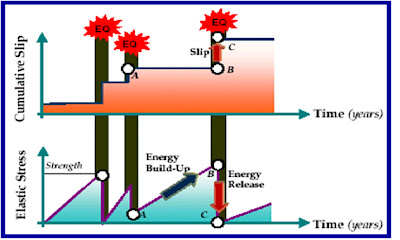Earthquake Happening
Earthquakes can never be avoided but lives can be saved with proper design
WELCOME TO THIS SITE
You are most welcome to this site.You can get rich information about earthquakes
You are most welcome to this site.You can get rich information about earthquakes
Wednesday, 14 September 2011
Body Waves
Body Waves:
Some waves are not restricted to the surface of a medium but can travel through its interior. Examples of these include acoustic waves (sound waves) and light waves. These are known as body waves and they fall into two categories:
i) Primary-waves
ii) Secondary waves
Seismic Waves
Seismic Waves:
Ø During fault ruptures which cause earthquakes, the sudden breakage and movement along the fault can release enormous amounts of energy.
Ø Some of this energy is used up in cracking and pulverizing the rock as the two blocks of rock separated by the fault grind past each other.
Ø Part of the energy, however, speeds through the rock as seismic waves. These waves can travel for and cause damage at great distances. Once they start, these waves continue through the earth until their energy is used up.
Saturday, 10 September 2011
Friday, 9 September 2011
Thursday, 8 September 2011
Tuesday, 6 September 2011
Elastic Rebound Theory
Elastic Rebound Theory
Ø This theory was discovered by making measurements at a number of points across a fault. Prior to an earthquake it was noted that the rocks adjacent to the fault were bending.
Ø These bends disappeared after an earthquake suggesting that the energy stored in bending the rocks was suddenly released during the earthquake.
WHAT CAUSES EARTHQUAKES?
Ø Over the course of time, one can observe that the two sides of an active fault are in slow but continuous movement relative to one another. This movement is known as fault slip.
Ø The rate of this movement may be as little as a few inches or so per year
Ø We can infer the existence of conditions or forces deep within the fault which resist this relative motion of the two sides of the fault.
Ø This is because the motion along the fault is accompanied by the gradual buildup of elastic strain energy within the rock along the fault.
Ø The rock stores this strain like a giant spring being slowly tightened.
Ø Eventually, the strain along the fault exceeds the limit of the rocks at that point to store any additional strain. The fault then ruptures--that is, it suddenly moves a comparatively large distance in a comparatively short amount of time.
Ø The rocky masses which form the two sides of the fault then "snap" back into a new position. This snapping back into position, upon the release of strain, is the "elastic rebound" of Reid's theory
Monday, 5 September 2011
What Is Earthquake
An earthquake is the vibration, sometimes violent, of the Earth's surface that follows a release of energy in the Earth's crust. This energy can be generated by a sudden dislocation of segments of the crust, by a volcanic eruption, or even by man made explosions.
Most destructive earthquakes--the kind which people generally have in mind when they think about earthquakes, and those of the greatest human and scientific significance--are caused by the sudden dislocation of large rock masses along geological faults within the earth's crust. These are known as tectonic earthquakes.
Subscribe to:
Comments (Atom)







